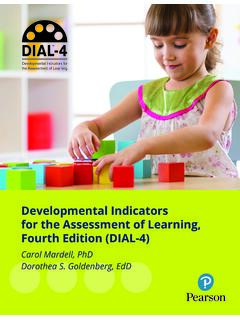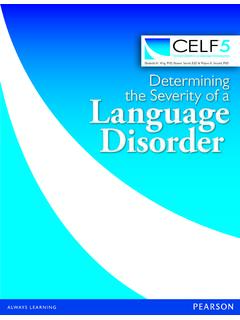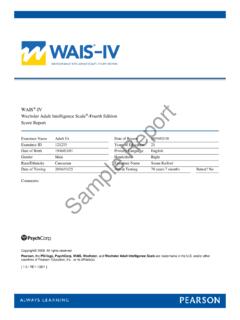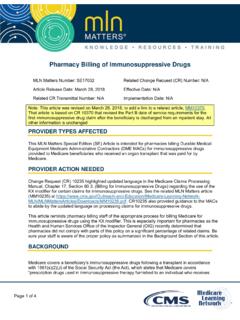Transcription of Case Description: Mr. J – Interpretive Report
1 SAMPLE REPORTCase Description: Mr. J Interpretive ReportMr. J is a 44-year-old divorced man assessed at intake for services at a community mental health center following a brief stay at a crisis stabilization unit. Mr. J was taken to the stabilization unit by law enforcement personnel after a serious suicide attempt involving vehicular carbon monoxide poisoning. He had been involved in very contentious divorce- and child custody-related proceedings for two years prior to this attempt. In addition to having a conflictual relationship with his ex-wife, Mr. J was estranged from his two teenage children, and he had minimal sources of social support. His only prior contact with a mental health professional involved a child custody evaluation conducted two years prior to the current assessment.
2 Mr. J s ex-wife was granted full custody minus planned bi-weekly visitations with Mr. J. The worker who conducted Mr. J s intake interview described him as depressed, despondent, tearful, and withdrawn. He was characterized as speaking in a monotone and giving laconic responses to questions he was asked. He was fully oriented and showed no signs of thought disturbance. No significant history of acting out behavior was elicited. Mr. J acknowledged continuing suicidal ideation but denied current intent. He was diagnosed with a Major Depressive Disorder, Severe with Melancholic Features and accepted for treatment in an intensive outpatient descriptions do not accompany MMPI-3 reports, but are provided here as background information. The following Report was generated from Q-global , Pearson s web-based scoring and reporting application, using Mr.
3 J s responses to the MMPI-3. Additional MMPI-3 sample reports, product offerings, training opportunities, and resources can be found at 2020 Pearson Education, Inc. or its affiliates. All rights reserved. Pearson, Q-global, and Q Local are trademarks, in the US and/or other countries, of Pearson plc. MMPI is a registered trademark of the Regents of the University of Minnesota. CLINA24805-A EL 6/20 Interpretive Report : Clinical SettingsMMPI -3 Minnesota Multiphasic Personality Inventory -3 Yossef S. Ben-Porath, PhD, & Auke Tellegen, PhDID Number: Mr. J Age: 44 Gender: Male Marital Status: Not reported Years of Education: Not reported Date Assessed: 08/01/2020 Copyright 2020 by the Regents of the University of Minnesota. All rights reserved. Distributed exclusively under license from the Universityof Minnesota by NCS Pearson, Inc.
4 Portions reproduced from the MMPI-3 test booklet. Copyright 2020 by the Regents of the University ofMinnesota. All rights reserved. Portions excerpted from the MMPI-3 Manual for Administration, Scoring, and Interpretation. Copyright 2020by the Regents of the University of Minnesota. All rights reserved. Portions excerpted from the MMPI-3 Technical Manual. Copyright 2020by the Regents of the University of Minnesota. All rights reserved. Used by permission of the University of Minnesota Multiphasic Personality Inventory and MMPI are registered trademarks of the University of Minnesota. Pearson is a trademarkin the and/or other countries of Pearson Education, Inc., or its affiliate(s).This Report contains copyrighted material and trade secrets. Qualified licensees may excerpt portions of this output Report , limited to theminimum text necessary to accurately describe their significant core conclusions, for incorporation into a written evaluation of the examinee, inaccordance with their profession's citation standards, if any.
5 No adaptations, translations, modifications, or special versions may be made ofthis Report without prior written permission from the University of Minnesota Press.[ / RE1 / QG1 ]SAMPLEMMPI-3 Validity Scales2010090807060504030 KLFBSFsFpFTRINVRINRaw Score:Response %:CRINVRINTRINC ombined Response InconsistencyVariable Response InconsistencyTrue Response Inconsistency139 FFpFsFBSRBSI nfrequent ResponsesInfrequent Psychopathology ResponsesInfrequent Somatic ResponsesSymptom Validity ScaleResponse Bias Scale1471508661454951036858120110 Cannot Say (Raw):13T Score:TT-------------------------------- -------------------------LKUncommon VirtuesAdjustment ValidityRBS238 The highest and lowest T scores possible on each scale are indicated by a "---"; MMPI-3 T scores are -3 Interpretive Report : Clinical Settings ID: Mr.
6 J08/01/2020, Page 2 SAMPLEMMPI-3 Higher-Order (H-O) and Restructured Clinical (RC) Scales2010090807060504030RC9RC8RC7RC6RC4 RC2RC1 RCdBXDTHDEIDRaw Score:T Score:Response %:EIDTHDBXDE motional/Internalizing DysfunctionThought DysfunctionBehavioral/Externalizing Dysfunction348095 RCdRC1RC2RC4 DemoralizationSomatic ComplaintsLow Positive EmotionsAntisocial BehaviorRC6RC7RC8RC9 Ideas of PersecutionDysfunctional Negative EmotionsAberrant ExperiencesHypomanic Activation246100178010044410024910010759 3655100150931441001055100136100120110 Higher-OrderRestructured Clinical-------------------------------- ----------------------------------The highest and lowest T scores possible on each scale are indicated by a "---"; MMPI-3 T scores are -3 Interpretive Report : Clinical Settings ID: Mr. J08/01/2020, Page 3 SAMPLEMMPI-3 Somatic/Cognitive Dysfunction and Internalizing Scales2010090807060504030 NFCARXCMPSTRBRFANPWRYNUCEATHLPCOGSFDRaw Score:T Score:Response %:MLSNUCEATCOGM alaiseNeurological ComplaintsEating ConcernsCognitive Complaints559100 WRYCMPARXANPBRFW orryCompulsivityAnxiety-Related ExperiencesAnger PronenessBehavior-Restricting FearsSUIHLPSFDNFCSTRS uicidal/Death IdeationHelplessness/HopelessnessSelf-Do ubtInefficacyStress310014610004410003810 0786100977100778100568100349665100759100 26310035192 Somatic/CognitiveInternalizing120110---- ---------------------------------------- ---------------------------------------- MLS8872 SUIThe highest and lowest T scores possible on each scale are indicated by a "---".
7 MMPI-3 T scores are -3 Interpretive Report : Clinical Settings ID: Mr. J08/01/2020, Page 4 SAMPLEMMPI-3 Externalizing and Interpersonal Scales2010090807060504030 SFISHYSAVACTIMPSUBJCPAGGDSFCYNDOMRaw Score:T Score:Response %:ACTAGGCYNA ctivationAggressionCynicism559 FMLJCPSUBIMPF amily ProblemsJuvenile Conduct ProblemsSubstance AbuseImpulsivitySFIDOMDSFSAVSHYSelf-Impo rtanceDominanceDisaffiliativenessSocial AvoidanceShyness141145458148149137955134 555458 InterpersonalExternalizing120110-------- ---------------------------------------- ------------------------The highest and lowest T scores possible on each scale are indicated by a "---"; MMPI-3 T scores are -3 Interpretive Report : Clinical Settings ID: Mr. J08/01/2020, Page 5 SAMPLEMMPI-3 PSY-5 Scales2010090807060504030 INTRNEGEDISCPSYCAGGRRaw Score:T Score:Response %:AGGRPSYCDISCNEGEINTRA ggressivenessPsychoticismDisconstraintNe gative Emotionality/NeuroticismIntroversion/Low Positive Emotionality1319386012689355010014710012 0110------------------------------86 The highest and lowest T scores possible on each scale are indicated by a "---"; MMPI-3 T scores are -3 Interpretive Report : Clinical Settings ID: Mr.
8 J08/01/2020, Page 6 SAMPLEMMPI-3 T SCORES (BY DOMAIN)PROTOCOL VALIDITYSUBSTANTIVE SCALES*The test taker provided scorable responses to less than 90% of the items scored on this scale. See the relevant profile page for the specificpercentage. Scale scores shown in bold font are interpreted in the Report . Note. This information is provided to facilitate interpretation following the recommended structure for MMPI-3 interpretation in Chapter 5 of theMMPI-3 Manual for Administration, Scoring, and Interpretation, which provides details in the text and an outline in Table Non-Responsiveness13393954 TCNSCRINVRINTRINOver-Reporting66*5047515 8 FFpFsFBSRBSU nder-Reporting3638 LKSomatic/Cognitive Dysfunction4659384446RC1 MLSNUCEATCOGE motional Dysfunction808072867877 EIDRCdSUIHLPSFDNFC7560*RC2 INTR55686549*59516368RC7 STRWRYCMPARXANPBRFNEGET hought Dysfunction4950 THDRC644RC847 PSYCB ehavioral Dysfunction445559*4858 BXDRC4 FMLJCPSUB3645414955RC9 IMPACTAGGCYN50 DISCI nterpersonal Functioning3734*3158*55*69 SFIDOMAGGRDSFSAVSHYMMPI -3 Interpretive Report : Clinical Settings ID: Mr.
9 J08/01/2020, Page 7 SAMPLESYNOPSISS cores on the MMPI-3 Validity Scales raise concerns about the possible impact of unscorable responses on thevalidity of this protocol. With that caution noted, scores on the Substantive Scales indicate emotional, behavioral,and interpersonal dysfunction. Emotional-internalizing findings include suicidal ideation, demoralization, lack ofpositive emotions, helplessness and hopelessness, self-doubt, perceived inefficacy, negative emotionality, stress,and worry. Behavioral-externalizing problems relate to lack of energy and engagement. Interpersonal difficultiesinclude lack of self-esteem and social VALIDITYC ontent Non-Responsiveness Unscorable Responses The test taker answered less than 90% of the items on the following scales. The resulting scores may thereforebe artificially lowered.
10 In particular, the absence of elevation on these scales is not interpretable1. A list of all itemsfor which the test taker provided unscorable responses appears under the heading "Item-Level Information." Infrequent Responses (F): 89%Compulsivity (CMP): 88%Family Problems (FML): 80%Dominance (DOM): 89%Disaffiliativeness (DSF): 57%Social Avoidance (SAV): 78%Introversion/Low Positive Emotionality (INTR): 86%Inconsistent Responding The test taker responded to the items in a consistent manner, indicating that he responded The test taker may have over-reported general psychological dysfunction. The extent of possible over-reportingcannot be precisely determined because of 4 unscorable responses on the 35-item Infrequent Responses (F)scale. The following table shows what the T scores for F would be if the unscorable items had been answered inthe keyed Interpretive Report is intended for use by a professional qualified to interpret the information it contains should be considered in the context of the test taker's background, thecircumstances of the assessment, and other available Report includes extensive annotation, which appears as superscripts following each statement in thenarrative, keyed to Endnotes with accompanying Research References, which appear in the final twosections of the Report .













